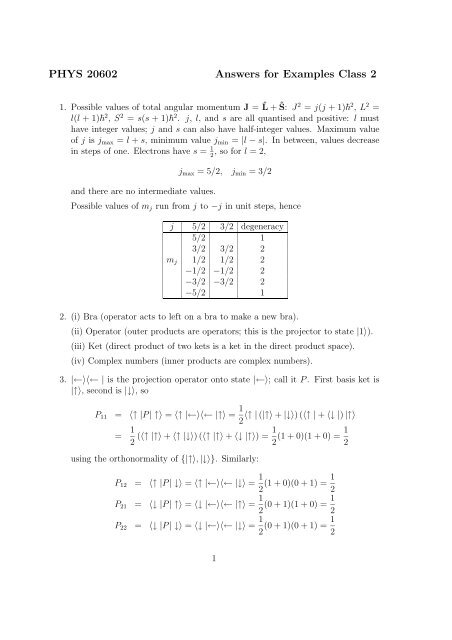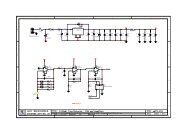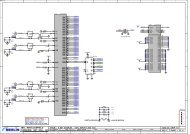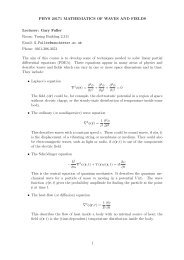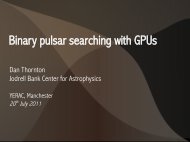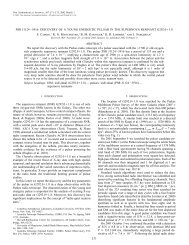PHYS 20602 Answers for Examples Class 2
PHYS 20602 Answers for Examples Class 2
PHYS 20602 Answers for Examples Class 2
You also want an ePaper? Increase the reach of your titles
YUMPU automatically turns print PDFs into web optimized ePapers that Google loves.
<strong>PHYS</strong> <strong>20602</strong> <strong>Answers</strong> <strong>for</strong> <strong>Examples</strong> <strong>Class</strong> 2<br />
1. Possible values of total angular momentum J = ˆL + Ŝ: J 2 = j(j + 1) 2 , L 2 =<br />
l(l + 1) 2 , S 2 = s(s + 1) 2 . j, l, and s are all quantised and positive: l must<br />
have integer values; j and s can also have half-integer values. Maximum value<br />
of j is j max = l + s, minimum value j min = |l − s|. In between, values decrease<br />
in steps of one. Electrons have s = 1 , so <strong>for</strong> l = 2,<br />
2<br />
and there are no intermediate values.<br />
j max = 5/2, j min = 3/2<br />
Possible values of m j run from j to −j in unit steps, hence<br />
j 5/2 3/2 degeneracy<br />
5/2 1<br />
3/2 3/2 2<br />
m j 1/2 1/2 2<br />
−1/2 −1/2 2<br />
−3/2 −3/2 2<br />
−5/2 1<br />
2. (i) Bra (operator acts to left on a bra to make a new bra).<br />
(ii) Operator (outer products are operators; this is the projector to state |1〉).<br />
(iii) Ket (direct product of two kets is a ket in the direct product space).<br />
(iv) Complex numbers (inner products are complex numbers).<br />
3. |←〉〈← | is the projection operator onto state |←〉; call it P. First basis ket is<br />
|↑〉, second is |↓〉, so<br />
P 11<br />
= 〈↑ |P | ↑〉 = 〈↑ |←〉〈← |↑〉 = 1 〈↑ | (|↑〉 + |↓〉) (〈↑ | + 〈↓ |) |↑〉<br />
2<br />
= 1 2 (〈↑ |↑〉 + 〈↑ |↓〉) (〈↑ |↑〉 + 〈↓ |↑〉) = 1 2 (1 + 0)(1 + 0) = 1 2<br />
using the orthonormality of {|↑〉, |↓〉}. Similarly:<br />
P 12 = 〈↑ |P | ↓〉 = 〈↑ |←〉〈← |↓〉 = 1 2 (1 + 0)(0 + 1) = 1 2<br />
P 21 = 〈↓ |P | ↑〉 = 〈↓ |←〉〈← |↑〉 = 1 2 (0 + 1)(1 + 0) = 1 2<br />
P 22 = 〈↓ |P | ↓〉 = 〈↓ |←〉〈← |↓〉 = 1 2 (0 + 1)(0 + 1) = 1 2<br />
1
So the matrix<br />
[P] =<br />
Eigenvalues and eigenvectors:<br />
( )<br />
P11 P 12<br />
P 21 P 22<br />
=<br />
( 1<br />
2<br />
(a) Smart way: since P is a projector, it has eigenvalues 1 <strong>for</strong> eigenstate |←〉,<br />
and 0 <strong>for</strong> the eigenspace orthogonal to |←〉. Since we are in a 2-D space, the<br />
orthogonal eigenspace is 1-D and its basis ket is obviously |→〉. If you don’t<br />
already know the expansion <strong>for</strong> |→〉 in terms of {|↑〉, |↓〉}, use the general rule<br />
that the vector orthogonal to (a|1〉 + b|2〉) is (b ∗ |1〉 − a ∗ |2〉). In this case<br />
1<br />
2<br />
1<br />
2<br />
1<br />
2<br />
)<br />
.<br />
|↓〉 =<br />
|↑〉 − |↓〉<br />
.<br />
2<br />
(b) Standard way: Solve <strong>for</strong> eigenvalues p of P:<br />
1<br />
2<br />
∣<br />
− p ∣ ( )<br />
1 ∣∣∣ 2<br />
2 1<br />
1 1<br />
− p =<br />
2 2 2 − p − 1 4 = p2 − p = p(p − 1),<br />
hence eigenvalues are p = 0, 1. Solving <strong>for</strong> the eigenvectors, starting with p = 1:<br />
( 1 − p ) ( ) (<br />
1<br />
2 2 a −<br />
a<br />
1 1<br />
− p =<br />
+ ) ( )<br />
b<br />
2 2 0<br />
a<br />
b<br />
− b =<br />
0<br />
2 2 2 2<br />
i.e. a = b, so the eigenvector is<br />
|p = 1〉 −→ S z<br />
1 √2<br />
( 1<br />
1<br />
)<br />
.<br />
Similarly <strong>for</strong> eigenvalue 0:<br />
( a+b<br />
2<br />
a+b<br />
2<br />
) ( 0<br />
=<br />
0<br />
)<br />
,<br />
4. (i)<br />
i.e. a = −b so<br />
|p = 0〉 −→ S z<br />
1 √2<br />
( 1<br />
−1<br />
ˆM = Ŝz2<br />
+ 2<br />
2<br />
)<br />
.<br />
This is an operator equation so all terms should be operators. However, since<br />
multiplying by the identity has no effect we often don’t bother writing Î; but to<br />
be accurate we should say<br />
ˆM = Ŝz2<br />
+ 2 2 Î.<br />
2
Ĵ = ˆL + Ŝ<br />
J is an operator that acts on the combined (direct product) space of orbital<br />
angular momentum and spin, but ˆL and Ŝ act only on one (each) of these factor<br />
spaces. To be precise we should write<br />
Ĵ = ˆL ⊗ Î + Î ⊗ Ŝ.<br />
(ii) In the equation<br />
ˆL z |m = 0〉 = 0,<br />
the ‘0’ on the right-hand side is the zero vector (zero ket), since the LHS (operator<br />
acting on ket) evaluates to a ket, not to a scalar.<br />
5. (a) Given that we know H = AL 2 x, which is a function of L x , its eigenvalues<br />
will be the same functions of the L x eigenvalues. L x must have the same<br />
eigenvalues as L z , since x and z are just conventional labels. For l = 1, the<br />
eigenvalues of L z and L x are , 0, and −. Hence we expect eigenvalues of<br />
H to be<br />
A 2 × (1, 0, 1)<br />
Check by explicitly solving the matrix. For speed, solve the matrix without<br />
the pre-factor (call it H ′ ) and then multiply the eigenvalues by A 2 /2:<br />
1 − m 0 1<br />
det(H ′ − mI) =<br />
0 2 − m 0<br />
∣ 1 0 1 − m ∣<br />
= (1 − m)[(2 − m) × (1 − m) − 0] − 0 + 1 × [0 − (2 − m) × 1]<br />
= (2 − m)[1 − 2m + m 2 − 1] = (2 − m)m(m − 2),<br />
i.e. m = (2, 0, 2) and hence energy eigenvalues are E = A 2 (1, 0, 1) as<br />
expected.<br />
The ground state is the lowest energy value, in this case E = 0. Hence the<br />
eigenvector satisfies:<br />
⎛<br />
⎝<br />
1 0 1<br />
0 2 0<br />
1 0 1<br />
⎞⎛<br />
⎠⎝<br />
a<br />
b<br />
c<br />
⎞<br />
⎠ = 0,<br />
i.e. a + c = 0 and 2b = 0. Hence the normalised ground state ket is<br />
⎛ ⎞<br />
|E = 0〉 −→ 1<br />
1<br />
L z √2 ⎝ 0 ⎠ .<br />
−1<br />
3
(b) The state with m = −1 is an eigenstate of L z , hence one of our basis kets;<br />
in fact it is the third basis ket as we always list the eigenvalues in the order<br />
, 0, −. So<br />
⎛ ⎞<br />
|m = −1〉 −→ 0<br />
L z<br />
⎝ 0 ⎠<br />
1<br />
Per the question, write this as |m = −1〉 = a|E = 0〉 + |φ〉 where a and |φ〉<br />
are unknown, but 〈φ|E = 0〉 = 0, i.e. |φ〉 is a vector in the subspace with<br />
excited energy E = A 2 .<br />
where<br />
⎛<br />
⎝<br />
0<br />
0<br />
1<br />
⎞<br />
⎠ = a √<br />
2<br />
⎛<br />
⎝<br />
⎛<br />
(1, 0, −1) ⎝<br />
x<br />
y<br />
z<br />
⎞<br />
1<br />
0<br />
−1<br />
⎞<br />
⎛<br />
⎠ + ⎝<br />
x<br />
y<br />
z<br />
⎞<br />
⎠<br />
⎠ = (x − z) = 0,<br />
so the excited subspace contains any vector with x = z. The solution may<br />
be obvious; <strong>for</strong>mally we have to solve:<br />
⎛ ⎞ ⎛<br />
0 a/ √ ⎞<br />
2 + x<br />
⎝ 0 ⎠ = ⎝ y<br />
1 −a/ √ ⎠ ,<br />
2 + x<br />
hence y = 0, x = −a/ √ 2, and − √ 2a = 1:<br />
⎛ ⎞ ⎛ ⎞<br />
0<br />
⎝ 0 ⎠ = 1 1<br />
⎝ 0 ⎠ − 1 2 2<br />
1 1<br />
The two terms have energies A 2 and 0, so we can apply the time evolution<br />
operator to get the state at time t:<br />
⎛ ⎞<br />
|Ψ(t)〉 = e −iHt/ |m = −1〉 = e −iAt |φ〉−e 0 √ 1 |E = 0〉 −→ e<br />
1<br />
−iAt − 1<br />
L z<br />
⎝ 0 ⎠ .<br />
2 2<br />
e −iAt + 1<br />
⎛<br />
⎝<br />
1<br />
0<br />
−1<br />
This is a bit more illuminating if we pull out an overall phase factor:<br />
⎛<br />
⎞ ⎛<br />
|Ψ(t)〉 −→ e −iAt/2 e −iAt/2 − e iAt/2 −i sin(At/2)<br />
L z<br />
⎝<br />
0 ⎠ = e −iAt/2 ⎝ 0<br />
2<br />
e −iAt/2 + e iAt/2 cos(At/2)<br />
The ion oscillates between L z = − and L z = , but without passing<br />
through L z = 0.<br />
⎞<br />
⎠ .<br />
⎞<br />
⎠.<br />
4


